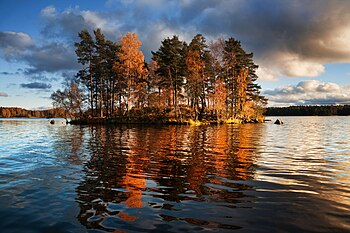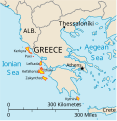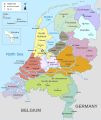Portal:Islands
The Islands Portal
This is a list of the lists of islands in the world grouped by country, by continent, by body of water, and by other classifications. For rank-order lists, see the other lists of islands below. (Full article...)
Selected article –

Japan is an island country in East Asia. It is in the northwest Pacific Ocean and is bordered on the west by the Sea of Japan, extending from the Sea of Okhotsk in the north toward the East China Sea, Philippine Sea, and Taiwan in the south. Japan is a part of the Ring of Fire, and spans an archipelago of 14,125 islands, with the four main islands being Hokkaido, Honshu (the "mainland"), Shikoku, and Kyushu. Tokyo is the country's capital and largest city, followed by Yokohama, Osaka, Nagoya, Sapporo, Fukuoka, Kobe, and Kyoto.
The Japanese archipelago has been inhabited since the Upper Paleolithic (30,000 BC). Between the fourth and ninth centuries AD, the kingdoms of the region became unified under an emperor and the imperial court based in Heian-kyō. Beginning in the 12th century, political power was held by a series of military dictators (shōgun) and feudal lords (daimyō), and enforced by a class of warrior nobility (samurai). After a century-long period of civil war, the country was reunified in 1603 under the Tokugawa shogunate, which enacted an isolationist foreign policy. In 1854, a United States fleet forced Japan to open trade to the West, which led to the end of the shogunate and the restoration of imperial power in 1868. In the Meiji period, the Empire of Japan adopted a Western-modeled constitution, and pursued a program of industrialization and modernization. Amidst a rise in militarism and overseas colonization, Japan invaded China in 1937 and entered World War II as an Axis power in 1941. After suffering defeat in the Pacific War and two atomic bombings, Japan surrendered in 1945 and came under a seven-year Allied occupation, during which it adopted a new constitution. (Full article...)
Selected cuisines, dishes and foods –
Bahamian cuisine refers to the foods and beverages of The Bahamas. It includes seafood such as fish, shellfish, lobster, crab, and conch, as well as tropical fruits, rice, peas, pigeon peas, and pork. Popular seasonings commonly used in dishes include chilies (hot pepper), lime, tomatoes, onions, garlic, allspice, ginger, cinnamon, rum, and coconut. Rum-based beverages are popular on the islands. Since the Bahamas consist of a multitude of islands, notable culinary variations exist.
Bahamian cuisine is somewhat related to that of the American South, with dishes held in common such as "fish 'n' grits". A large portion of Bahamian foodstuffs are imported (cf. economy of the Bahamas). International cuisine is offered, especially at hotels. (Full article...)Related articles
- List articles
- List of islands
- List of islands by area
- List of islands by highest point
- List of islands by name
- List of islands by population
- List of islands by population density
- List of archipelagos
- List of archipelagos by number of islands
- List of artificial islands
- List of divided islands
- List of fictional islands
- List of island countries
- List of islands in lakes
- List of islands named after people
- List of islands of the European Union
- List of private islands
Selected image –

Did you know –

- ... that Bridgeman Island was the first volcano in Antarctica to be seen erupting?
- ... that a decline in the sale of stamps from the Pitcairn Islands led to the territory's bankruptcy?
- ... that more than 100 traps were set to catch a single stoat on an otherwise predator-free island in Taiari / Chalky Inlet in 2022?
- ... that 80 acres (32 ha) of Hog Island were farmland in 1923, but only 15 acres (6 ha) were above water in 1974?
- ... that the coat of arms of Jersey was allowed to be featured on its stamps during the occupation in World War II, with the Germans unaware that it was also the royal arms of England?
- ... that a 1956 eruption of Bristol Island drove Argentina to abandon a hut they had built on Thule Island?
General images –
Related portals
WikiProjects
Topics
Categories
Associated Wikimedia
The following Wikimedia Foundation sister projects provide more on this subject:
-
Commons
Free media repository -
Wikibooks
Free textbooks and manuals -
Wikidata
Free knowledge base -
Wikinews
Free-content news -
Wikiquote
Collection of quotations -
Wikisource
Free-content library -
Wikiversity
Free learning tools -
Wikivoyage
Free travel guide -
Wiktionary
Dictionary and thesaurus
Things to do
 |
Here are some tasks awaiting attention:
|
Web resources
- Listing of islands from the United Nations Island Directory




























































![Image 59The Shamanka Шаманка [ru], a holy rock in Shamanism and one of the 9 most holy places in Asia, on the westcoast of Olkhon (from List of islands of Russia)](http://upload.wikimedia.org/wikipedia/commons/thumb/2/27/Shaman_Kamen.jpg/120px-Shaman_Kamen.jpg)





































